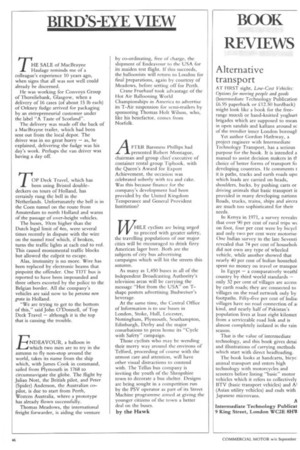BOOK REVIEWS
Page 48

If you've noticed an error in this article please click here to report it so we can fix it.
Alternative transport
AT FIRST sight, Low-Cost Vehicles: Options for moving people and goods (Intermediate Technology Publication £6.95 paperback or £12.50 hardback) might look like a book for the freerange muesli or hand-knitted yoghurt brigades which are supposed to mean in open sandals and kaftans around sc of the trendier inner London borough
Yet author Gordon Hathway, a project engineer with Intermediate Technology Transport, has a serious purpose for the book. It is intended a manual to assist decision makers in a choice of better forms of transport fo developing countries. He comments t it is paths, tracks and earth roads upo which loads are carried on heads, shoulders, backs, by pushing carts or driving animals that basic transport is provided in many developing nations Roads, trucks, trains, ships and aircra are much too sophisticated for their needs.
In Kenya in 1971, a survey reveale( that over 90 per cent of rural trips wt on foot, four per cent were by bicycl and only two per cent were motorise. One Indian survey in the late Seventi revealed that 74 per cent of householi did not own any type of wheeled vehicle, while another showed that nearly 40 per cent of Indian househot spent no money on travel or transpor
In Egypt — a comparatively weathl country by third world standards — only 32 per cent of villages are access by earth roads; they arc connected to villages on the road network only by footpaths. Fifty-five per cent of India] villages have no road connection of am kind, and nearly half of Pakistan's population lives at least eight kilornet from a serviceable road link and is almost completely isolated in the rain season.
That is the value of intermediate technology, and this book gives detai and illustrations of carrying methods which start with direct headloading.
The book looks at handcarts, bicyc animal transport and enters high technology with motorcycles and scooters before listing "basic" motor vehicles which it refers to collectively BTV (basic transport vehicles) and Al (Asian utility vehicles) and ends with Japanese microvans.




































































































